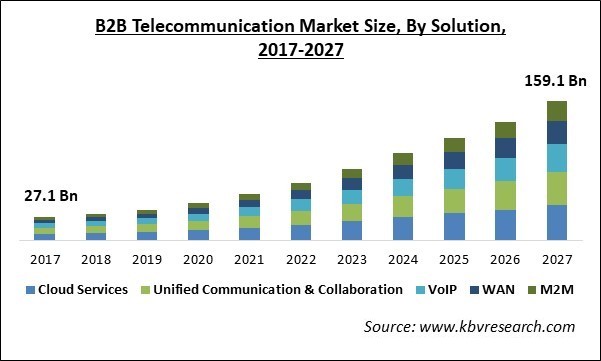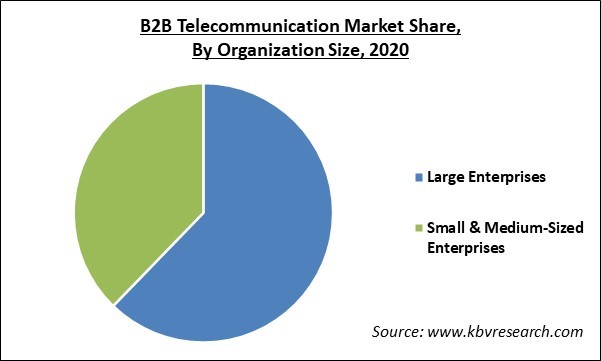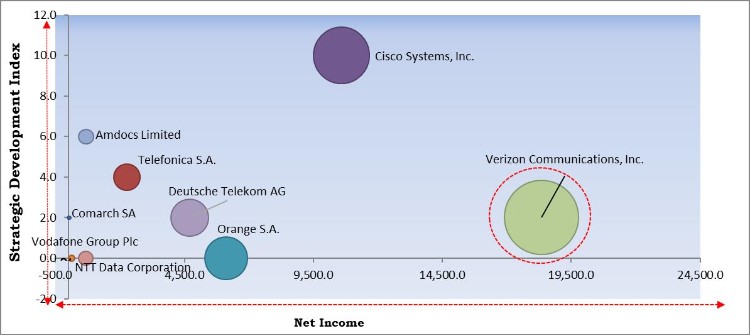The Global B2B Telecommunications Market size is expected to reach $159.06 billion by 2027, rising at a market growth of 20.2% CAGR during the forecast period.
B2B telecommunication refers to a kind of communication between businesses. This type of communication is different from communication between businesses and clients or clients and clients. In addition, these communications can occur in several mediums including fax, e-mail, radio, instant messaging, voice, sound, and video, which enable one-to-one communication between businesses. In addition, marketers are increasingly utilizing telecommunication platforms to fuel the visibility of their company within the market and explore different networking opportunities.
Business to business telecommunications used to be restricted to simple telephone and computer networks. Business representatives can now meet remotely via video conferencing and collaborate via cloud-based file sharing attributed to the increasing availability and lower prices of broadband Internet and data storage.

The outbreak of the COVID-19 pandemic brought an unparalleled challenge for humans, governments, and businesses. Governments around the world have formulated stringent lockdown guidelines to enforce COVID-appropriate behavior among the citizens. In addition, the global pandemic caused a spike in the demand for B2B telecommunication due to the increasing acceptance of the work-from-home model by many organizations.
To accept new normal and continue with the existing routines, telecommunication infrastructure and its services are playing a major role to keep employees and companies connected and running. Additionally, the majority of the organizations follow business continuity plans. However, these plans could not completely manage the rapidly growing and unspecified variables of an outbreak such as the COVID-19 pandemic.
In the last couple of years, there has been a massive adoption of the Internet of Things (IoT) across several industrial sectors. In addition, many manufacturers and factory owners are moving to digitalize their workflows and look for speed, reliability, and security of the networks they are attached to. Also, B2B telecommunication brought a transformation in smart factories, enabling owners to disassociate from fixed-line networks, obtain operational intelligence in real-time, and facilitate enhanced security.
The requirement for B2B telecommunication would be driven by the growing focus of companies in expanding their business and managing workforces around the world. Additionally, a large number of companies in different sectors like BFSI, government, corporate, education, and healthcare are rapidly embracing the technology to offer superior services to their clients during the COVID-19 pandemic to decrease the overhead cost and drive up the productivity of employees. In addition, many key market players are launching new software for varied industries to enhance security features and address the loopholes in communication between companies and workers.
Businesses across several industries are not willing to embrace sophisticated technologies due to the rise in the number of security issues. In addition, new technologies come along with the different types of security breaches that could grant permission to unauthorized users to gain access to valuable information. Additionally, the rise in the number of security risks along with cyber theft would create reluctance among worldwide companies to adopt B2B telecommunication services. Also, third-party owners manage these services for daily operation, which may fuel the possibility of data theft, information leak, and loss of data. Moreover, there is a need for the high cost to implement these solutions which is not easy for some small businesses facing budgetary constraints.

Based on Solution, the market is segmented into Cloud Services, Unified Communication & Collaboration, VoIP, WAN, and M2M. M2M communication segment would showcase a promising growth rate throughout the forecasting period. This is credited to the growing deployment of M2M communication solutions among several SMEs with an aim to increase the speed of communication across the enterprise.
Based on Organization Size, the market is segmented into Large Enterprises and Small & Medium-Sized Enterprises. SMEs segment would exhibit a significant growth rate in the market during the forecasting period. The growth of the segment is credited to the drastic rise in the number of small and medium-scale enterprises around the world.
Based on End User, the market is segmented into BFSI, Media & Entertainment, Retail & E-commerce, Healthcare, Telecom & IT, Government and Others. E-commerce platforms are increasingly using telecommunications to easily reaching to their broad customer base. Telecommunication systems also enable these platforms to expand their services to the national or worldwide market, which could result in higher sales and revenues.
| Report Attribute | Details |
|---|---|
| Market size value in 2020 | USD 42.8 Billion |
| Market size forecast in 2027 | USD 159.06 billion |
| Base Year | 2020 |
| Historical Period | 2017 to 2019 |
| Forecast Period | 2021 to 2027 |
| Revenue Growth Rate | CAGR of 20.2% from 2021 to 2027 |
| Number of Pages | 271 |
| Number of Tables | 402 |
| Report coverage | Market Trends, Revenue Estimation and Forecast, Segmentation Analysis, Regional and Country Breakdown, Competitive Landscape, Companies Strategic Developments, Company Profiling |
| Segments covered | Solution, Organization Size, End User, Region |
| Country scope | US, Canada, Mexico, Germany, UK, France, Russia, Spain, Italy, China, Japan, India, South Korea, Singapore, Malaysia, Brazil, Argentina, UAE, Saudi Arabia, South Africa, Nigeria |
| Growth Drivers |
|
| Restraints |
|
Based on Regions, the market is segmented into North America, Europe, Asia Pacific, and Latin America, Middle East & Africa. APAC would display a promising growth rate throughout the forecasting period. This is attributed to the existence of various large-scale manufacturers and the high accessibility of high-speed communication networks across the region.
Free Valuable Insights: Global B2B Telecommunication Market size to reach USD 159.06 billion by 2027

The major strategies followed by the market participants are Partnerships. Based on the Analysis presented in the Cardinal matrix; Verizon Communications, Inc. is the major forerunner in the B2B Telecommunication Market. Companies such as Cisco Systems, Inc., Orange S.A., Amdocs Limited are some of the key innovators in the Market.
The market research report covers the analysis of key stake holders of the market. Key companies profiled in the report include Cisco Systems, Inc., Orange S.A., Comarch SA, Telefonica S.A., Amdocs Limited, Vodafone Group Plc, Deutsche Telekom AG, NTT Data Corporation, AT&T, Inc. (AT&T Intellectual Property), and Verizon Communications, Inc.
By Solution
By Organization Size
By End User
By Geography
The global B2B telecommunication market size is expected to reach $159.06 billion by 2027.
Growing adoption of IoT are driving the market in coming years, however, Absence of security solutions have limited the growth of the market.
Cisco Systems, Inc., Orange S.A., Comarch SA, Telefonica S.A., Amdocs Limited, Vodafone Group Plc, Deutsche Telekom AG, NTT Data Corporation, AT&T, Inc. (AT&T Intellectual Property), and Verizon Communications, Inc.
Yes, The global pandemic caused a spike in the demand for B2B telecommunication due to the increasing acceptance of the work-from-home model by many organizations.
The Cloud Services market dominated the Global B2B Telecommunication Market by Solution 2020, thereby, growing at a CAGR of 18.6% during the forecast period.
The North America market dominated the Global B2B Telecommunication Market by Region 2020, and would continue to be a dominant market till 2027; thereby, achieving a market value of $58.55 Billion by 2027.
Our team of dedicated experts can provide you with attractive expansion opportunities for your business.

